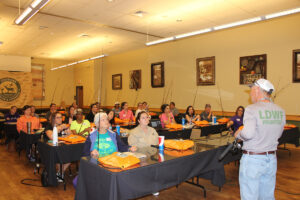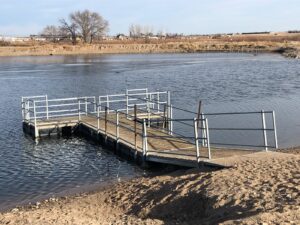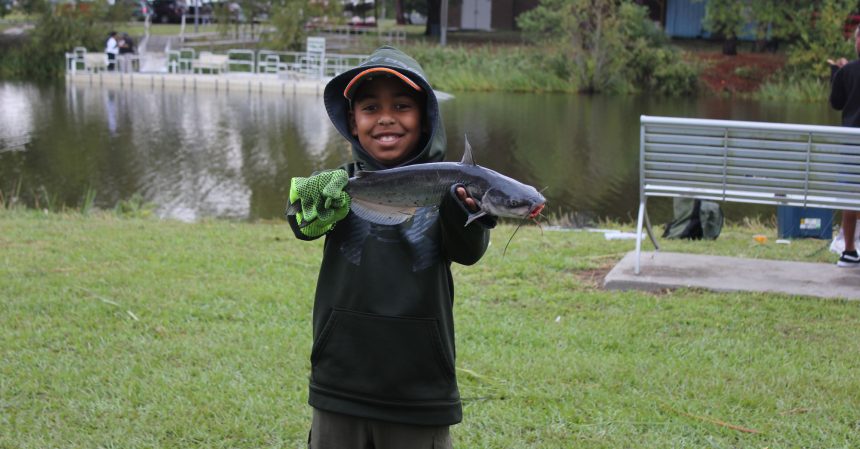By Tim Allard
Title image: A young angler at a Get Out and Fish! event hosted by the Louisiana Department of Wildlife and Fisheries at Joe Brown Park in New Orleans, Louisiana. Photo courtesy LDWF.
For more than half a century, America’s fishing equipment manufacturers have been part of a valuable partnership with federal and state governments focused on fisheries conservation and increasing public angling opportunities. Thanks to the Sport Fish Restoration (SFR) Act, excise taxes paid by manufacturers and taxes on motorboat fuel are used for SFR funding, which the U.S. Fish and Wildlife Service (USFWS) administers annually to state fish and wildlife agencies.
An important way state agencies use SFR funding is to support efforts to attract new anglers as well as to help keep current or lapsed anglers fishing. These activities contribute to a nationwide movement known as “R3” (recruit, retain, and reactivate), which seeks to increase the participation of anglers and other outdoor recreationists.
In addition to encouraging the public to enjoy America’s millions of acres of fishable water, growing angler participation is important because it supports state agency conservation efforts resulting from the SFR partnership which, in turn, benefits industry. Here’s a look at how three states use SFR funding for R3 initiatives to help more people go fishing.
Louisiana
SFR funding helps Louisiana’s Department of Wildlife and Fisheries (LDWF) sustain their successful Get Out and Fish! (GOF) community fishing program at 17 fishing ponds near cities and towns. Partnering with local governments and community groups, LDWF stocks ponds with adult channel catfish in the spring and fall, and rainbow trout in the winter.
“The goal is to increase participation in fishing in those communities [and] to make it easier to go fishing,” said Danica Williams, a LDWF Biologist Program Manager of Fisheries Outreach and Education. “Instead of needing to drive a long distance to go fishing, you can take a short drive and have more of a chance of actually putting fish in your ice chest to take home to eat.”
To launch a new GOF site, LDWF coordinates a fishing event to raise awareness of the location. Events include instructional clinics on catching, cleaning, and cooking fish available in the pond.
“Numbers from our game camera counts at each of our new sites, as well as an electronic check-in form, show a definite increase in fishing participation at each park after the ponds are stocked,” Williams said.
The program’s popularity is also visible in the traffic on GOF Facebook and Instagram pages. LDWF uses social media to recruit and interact with anglers, post information on stocking dates and derby information, answer questions, and share angler photos submitted through the GOF electronic, check-in survey. The latter is a tool LDWF uses for tracking participation and managing fish stocking.
LDWF’s Aquatic Volunteer Instructor program is another example of how SFR funding supports R3 efforts. The program consists of hands-on workshops where volunteers are trained on various angling and fisheries management topics (e.g., knot tying, casting techniques, fish identification, fisheries management, and fishing safety). Upon completion, trained volunteers can then use LDWF activity guides, lesson plans, educational resources, and equipment for promoting fishing, recruiting anglers, and teaching about fisheries science.

“LDWF’s outreach and education staff and volunteers average approximately 130 events each year,” Williams said. “LDWF has nearly 100 active certified Aquatic Volunteer Instructors…. Volunteers offer aquatic education at events such as fishing workshops, fishing tournaments, classroom and school lessons and activities, sportsman shows, and community events.”
Thanks to the funding provided by the SFR Act, LDWF biologists and volunteers are also able to deliver the sought-after Women Fishing Workshops. Workshops are open to any women over the age of 18 interested in learning about fishing. In addition to receiving excellent workshop instruction on many angling topics, participants may be randomly selected to attend a fishing weekend at LDWF’s Grand Isle Fisheries Research Lab. The getaway offers participants the opportunity to apply the skills they learned while fishing from a boat on Louisiana’s coast.
“They will fish inshore for redfish, speckled trout, flounder, sheepshead and also, if the weather is cooperating, have a chance to fish for some of our off shore species, including red snapper,” said Heather David, LDWF Outreach and Education Biologist Manager. “Then we bring them back to the lab [where] they learn how to clean those different species. They’ll also learn how to trailer and launch a boat, and cast a net for bait.”
California
The California Department of Fish and Wildlife (CDFW) has several R3 initiatives, including their popular Classroom Aquarium Education program. This hands-on, interdisciplinary project is suitable for grades K to 12 and known regionally as Trout, Salmon, or Steelhead in the Classroom.
“Trout in the Classroom is funded by SFR money and really educates people on the importance of aquatic resources, fisheries management, and there’s a component around the role that anglers play in generating dollars to sustain all of that,” said Jen Benedet, CDFW Assistant Deputy Director, Office of Communications, Education, and Outreach.
Fishing in the City (FIC) is another R3 program and provides angling opportunities for California’s urban and suburban residents. CDFW uses SFR funding to provide financial support to regionally managed FIC programs as well as for stocking ponds used by FIC.
“Fishing in the City has been really good at being flexible and adaptable to the communities and populations they serve, but also with the types of fishing that’s available in each region…. We have a huge coastline and then in the east we have lakes, streams, and rivers, and so there’s a huge difference between each program regionally.”
The Harvest Huddle Hour (R3H3), a live, virtual seminar series, is a more recent R3 success story. Benedet and her team created R3H3 as an interim solution to pandemic restrictions preventing traditional R3 activities, such as in-person fishing clinics. The seminars strive to increase skill development and confidence for adult beginners interested in fishing, hunting, shooting sports and foraging wild food in California. Seminars are streamed live via Zoom. Past recordings are available on CDWF’s website (here) and YouTube.
“The R3 team had to find a way to respond,” Benedet said. “More people were buying hunting and fishing licenses…, but we had no way to catch these people, provide them the social support needed, and teach them the skillset to participate, so we created the Harvest Huddle Hour as a simple response to that.”
R3H3 is supported by SFR funding and. based on participant interest and positive survey results, CDFW will continue R3H3 angling seminars for 2022.
Colorado
Since 1989, Colorado Parks and Wildlife’s (CPW) Fishing is Fun (FIF) program has enabled over 300 construction projects to improve angling opportunities. CPW uses SFR funds to provide annual FIF grants to local governments, angling organizations, and other groups for projects involving habitat restoration, public angling access improvements, new fishing pond development, and amenity improvements at fishing sites.
Several FIF projects along the Clear Creek Peaks to Plains trail have improved stream fishing opportunities near Denver. These projects illustrate the importance of fishing access for retaining and reactivating anglers. Jim Guthrie, CPW’s FIF Program Coordinator, explains:
“Trout Unlimited talked about the difficulty of access into Clear Creek, both parking because it’s a narrow, winding road for a lot of it, but also the [water] access was kind of scrambling down these rocks…. They specifically said, ‘You reach a certain age and it’s just hard to clamber over all these rocks to get down to the river.’”
To remedy these issues, safer parking locations were built. Fish habitat was also improved in areas close to existing parking to eliminate anglers needing to walk along the road to access quality fishing sites. Additionally, existing rocks were repositioned to create natural steps for safe, easy access to the stream.

SFR funding also supported a FIF renovation project completed in summer 2021 by Lamar’s parks department at Gateway Park ponds. The park is in southeastern Colorado, which has limited fishing opportunities.
“At Lamar, it might be 30 miles to the next opportunity, pond, or reservoir, to go fishing,” Guthrie said. “Gateway Park is a lot closer, it’s right on the north side of town and kids can ride their bikes up there.”
Building an ADA compliant fishing pier and enhancements made along shoreline areas have increased safe, public angling access. Like many FIF projects, Gateway Park added comfort amenities, including shade shelters with picnic tables and a restroom, which help families extend their fishing time and make the experience more user friendly. Ponds are also stocked with rainbow trout, largemouth bass, channel catfish, panfish, and other species. Despite renovations being recently completed, local CPW offers have noticed an increase in angling and park usage by the public.
Thanks to SFR funding, the FIF program is increasing angling opportunities, which subsequently, encourages more people to go fishing. Additionally, FIF construction projects pave the way, so to speak, for CPW and other groups to potentially use for R3 programming, such as hosting instructional fishing clinics.
The above programs and projects are just some examples of how SFR funds, obtained from fishing manufacturer paid excise taxes and motorboat fuel taxes, support nationwide R3 efforts to increase angling participation. As noted earlier, growing angler numbers can stimulate fishing-related spending, which helps state agencies manage fish habitat, increase public angling opportunities, and continue to welcome new anglers to the sport.

